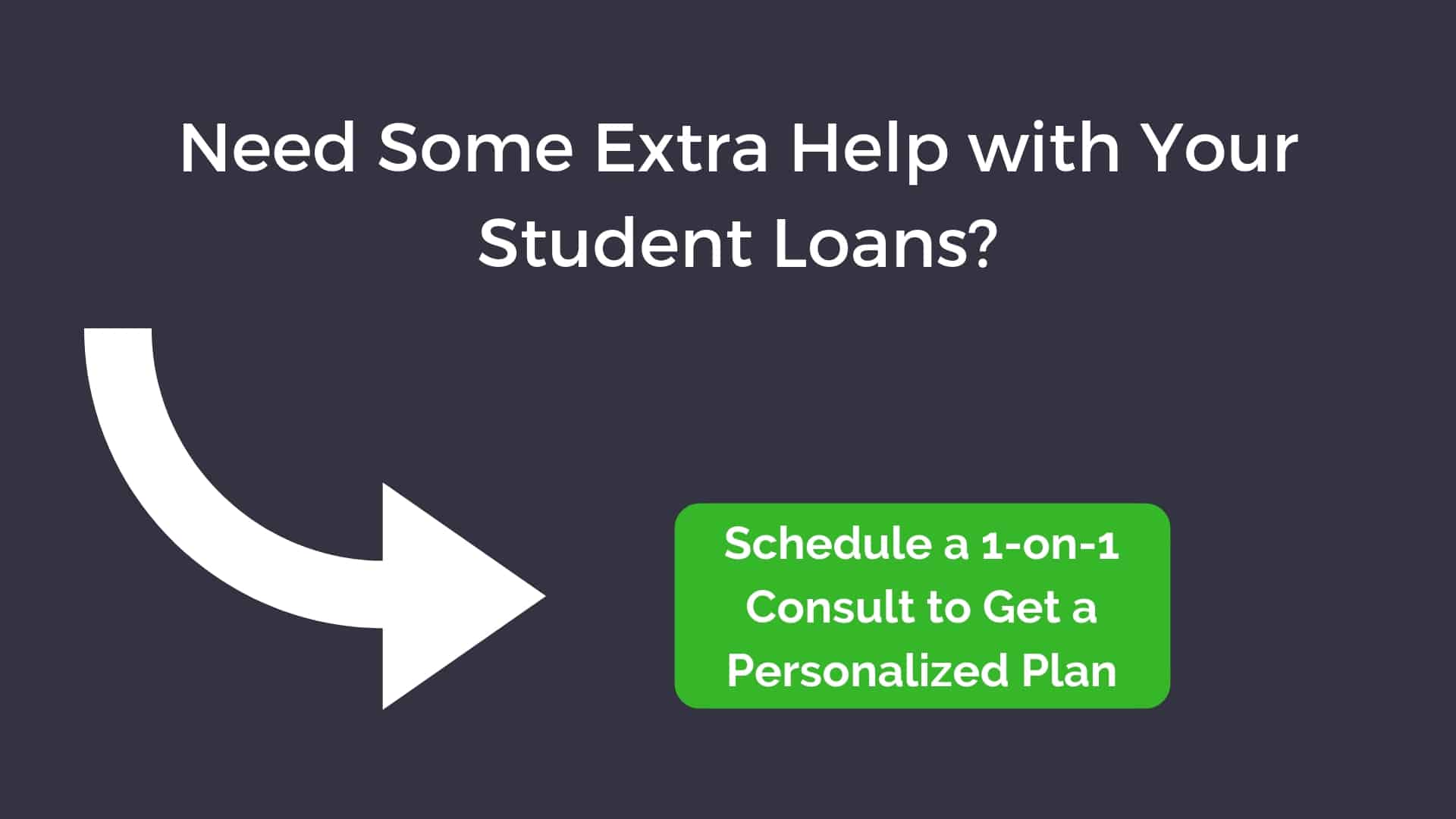New Book: Baker’s Dirty Dozen: Principles for Financial Independence
Joe Baker, author of the newly released book Baker’s Dirty Dozen: Principles for Financial Independence, joins Tim Ulbrich on the show. Joe talks about several of the principles outlined in the book, why he wrote the book and what he hopes the reader will glean from applying its principles.
About Today’s Guest
Joe Baker is an Adjunct Assistant Professor at the University of Arkansas for Medical Sciences College of Pharmacy where he has taught personal finance for over twenty years, as well as an adjunct instructor at Harding University College of Pharmacy. He holds a Bachelor of Business Administration from Southern Arkansas University and a Masters of Business Administration from the University of Central Arkansas. Joe retired early in 2019 from Pharmacists Mutual Company where he provided insurance and financial services to Arkansas pharmacists for twenty-eight years. Joe has spoken to both academic and corporate groups across the country promoting financial literacy.
In an effort to give back to his community, he has endowed a scholarship fund for students graduating from his hometown of Emerson, Arkansas.
Joe and his wife, Brenda, live in Little Rock, Arkansas.
Summary
Joe Baker has been teaching personal finance to pharmacists for over 20 years as an Adjunct Assistant Professor at the University of Arkansas for Medical Sciences College of Pharmacy as well as an adjunct instructor at Harding University College of Pharmacy. Tim Ulbrich approached Joe and asked if he’d be interested in writing a book and Joe realized there were a lot of lessons in personal finance he could share. With the help of his daughter Lindsey, Joe wrote over 250 pages of the key principles he teaches and has learned along his journey of personal finances. This book is composed of practical experience and contributions and stories from over 40 people.
In this episode, Joe walks through several of the principles he has written about like finding a path that will fulfill you, getting and staying out of debt, setting up a 401(k) and Roth IRA, finding the right house and picking the right mortgage, protecting your assets and making a difference in your community.
Through November 7th, you can use the coupon code BAKER at www.bakersdirtydozen.com for 15% off your order of the book.
Mentioned on the Show
- Baker’s Dirty Dozen: Principles for Financial Independence by Joe Baker, MBA with Lindsey Jordan Baker
- YFP 082: Debt Free Theme Hour with the Teacher & Pupil
- FinCon
- Ramit Sethi
- I Will Teach You to Be Rich: No Guilt. No Excuses. No BS. Just a 6 Week Program that Works by Ramit Sethi
Episode Transcript
Tim Ulbrich: Joe, welcome back to the show.
Joe Baker: Well, thank you, Tim, for the invite.
Tim Ulbrich: Excited to have you. Huge accomplishment as you release your new book, and we’re going to dig in and talk about several aspects of that book, really a comprehensive guide not only for pharmacy professionals but really just a guide overall about how to live a financially well life and how to do it with intention. And we had you on the show back on Episode 082 with Blake Johnson as he shared his debt-free journey. And during that show, Blake articulated how important your guidance was, your mentorship and your role as a teacher in terms of how important that was in the journey for he and his wife to becoming debt-free. And so now we get to talk about how you have compiled all of that wisdom that Blake and other students who have been blessed with your guidance and teachings often speak of as you release your new book, “Baker’s Dirty Dozen: Principles for Financial Independence.” So Joe, first of all, congratulations. I know a lot of sweat, a lot of time went into putting together this book. And here we are, finally getting ready to release it. So congrats.
Joe Baker: Yes, well thank you for talking me into it. I guess I say thank you.
Tim Ulbrich: So I have to ask, now that you’re on the back end of this and we finally get this into the hands of folks and many, many months of writing and editing went into this, and I told you very early on, I said, “Hey, Joe, at some point, this is going to become fun.” And you kept saying, “When is that? When is that?” So as you look now backwards, tell us about the process. What was it like? What type of time was involved? And would you do it again?
Joe Baker: Would I do it again? Yes, I would do it again. But I’d have open eyes this time. I had been thinking about writing a book for years. Former students and current students would say, “Why don’t you put this down on paper and let us have it in a book?” And I didn’t really think much about it until you mentioned — I think it was in May of last year, 2019 — you mentioned and said, “Hey, why don’t you write a book and we will help you promote it?” Then that got the bug started and I started thinking about it and said, you know, I think I can come up with some things. And on August the 15, I started the book. And coincidentally, I started writing the book for something to do in the hospital room. My wife was having some surgeries. And quite frankly, I wrote most of the book in the hospital room. Now, she’s fine today and everything went well. But you know, it was pretty tough having to write a book when someone’s over there moaning in pain. I’d have to call a nurse and say, “Hey, give us some pain pills in here. I’m trying to write my first book.” They weren’t too sympathetic, nor was my wife. But most of it was written, I mean, during the hospital stay. And what’s interesting — I tell people this story — is I thought I was pretty much finished at Christmas. And my daughter, who is just very astute on editing and all that sort of thing, she said, “Well, Dad, why don’t you let me read it and edit it?” I said, “OK. Go ahead.” Well, she started into editing the book, and lo and behold, she would say, “Dad, I don’t understand.” I said, “Lindsey, you’ve got to understand, I wrote this for millennials.” And she said, “Well, I don’t understand it.” So we went almost paragraph by paragraph throughout the book and rewrote it to where she could understand it as a liberal arts major and put in some stories. It was so much involved, involvement for her that I just felt obliged to name her a coauthor because she did, she made it sound so much better. I shouldn’t say this, but one day I was reading through it for the thousandth time, and I said, “You know, I know I’m getting old. But I don’t remember writing this part.” And she said, “Oh yeah, you did not. I put all that in.” I said, “OK.” There is a lot of her in this book, and I’m very proud of what she’s done.
Tim Ulbrich: And shoutout to Lindsey. I appreciated her input along the way. She did a fantastic job. I feel like it’s — as you know, Joe, as I know, especially as you’ve taught on this much longer than I have, it’s very different teaching on this and then putting that into writing in a way that is engaging, that is accessible, that is action-oriented. And I think it takes more effort, but one of the exciting things is this will live on, and it’s going to have an impact on many, many people. And just so folks understand the effort, when you talked about going paragraph by paragraph, we’re talking about paragraph by paragraph of over 250 pages that are in this book. And I think you did an awesome job. One of the first things I said to you after I read it was, “Wow, this is incredibly engaging because of the stories that you’ve included, because of the tone of writing, because of how action-oriented it is.” And you had over 40 people that helped contribute to the book. And I say that as we get ready to jump into talking about some of the key principles because I think this is a topic where multiple perspectives can be helpful to reinforce various points. And I love how you brought in those perspectives and obviously Lindsey put her own stamp on the book as well. So just overall, incredible job. And we’ve got — I think you have photo evidence of some of that hard work writing. I remember you sent me a text at one point with a photo when you were in the hospital writing. And so we’ve got photo evidence of that. So again, congratulations.
Joe Baker: Well thank you. Can I add another story to this? And it kind of goes to one of the reasons I was writing the book is we were playing cards this summer — and by the way, I had my other daughter, Brooke, and her husband, Gabe Crooks, to edit the book. And they did a good job. They weren’t as in depth as Lindsey, but they did do that. We were playing cards, and Gabe and my daughter happened to be there, and we had a big group there playing cards at the table, and one of the card members, one of our friends who is an attorney, says, “Well I couldn’t tell you the difference between an IRA and a Roth IRA.” And all of a sudden, to my right, Gabe, my son-in-law, another liberal arts major, he started explaining the difference, how it’s the taxation, you know, you tax up front and all of that, went into great detail. And I turned to him and I said, “How’d you know that?” He said, “By editing your book.”
Tim Ulbrich: There you go.
Joe Baker: And he’s even starting investing more and more from that. So it seems to have worked.
Tim Ulbrich: That’s great. And I think you know from teaching this for over 20 years as we’ve had several of your former students on this podcast, you know, some people will read this book and go line-by-line and take away multiple things that they’ll apply. Others may take one thing or they’ll jump in and out as their financial life and plan progresses. But I am confident, I know I took many things away, and I’m confident the readers will do the same. Joe, remind our listeners — maybe they didn’t hear you on Episode 082 way back when — a little bit of your career path and then also some of the work that you’ve done over the past 20 years in teaching personal finance. I think it’s a good segway into why you even wrote this book in the first place.
Joe Baker: Well, in my adult life, I’ve worked for 28 years with Pharmacists Mutual companies, so I’m very familiar with pharmacists and pharmacy students. And I spent a lot of time in the college of pharmacy. And in the late ‘90s, I was talking to the assistant dean and the dean about a personal finance course. And one thing led to another, and we started in the fall of ‘99 at the University of Arkansas College of Pharmacy, a two-hour elective for P3s. And I’m going to brag not because of me but because of the content, it is the most popular elective at the university. So it’s been going on for over 21 years. And it’s just — it’s been great. I look forward to it. Pharmacy students are like sponges, they just absorb it all. And we just — we have a good time. We tell a lot of stories. And I learn from them as well. So it’s a two-way street.
Tim Ulbrich: Absolutely. And I have been teaching a personal finance elective for I think 4 or 5 years, not 20+ years. But one of the things I often think of is, I wish I would have had this. And I know I hear that from others as well. So lucky to have the students that have been able to take your course, that they have access to that information. And Joe, I wanted to ask, you know, we throw around the term, “financial independence,” “financial freedom,” all the time. And since it’s in the subtitle of your book, “Principles for financial independence,” I want our listeners to hear from you, what does that term mean to you? And why is that concept of financial independence so important?
Joe Baker: Well financial independence to me means that if I want to pick up roots, move to another place, I can. I’m not obliged to stay at the same job that I’m in. It just frees you up to do so many things. And I know that money can’t buy happiness, but I have been without money, and that has made it very unhappy. It’s nice to know that if the refrigerator breaks down, the wash machine, or if you want to go on a trip, that you don’t really have to think that much about the monetary. I know I always try to get a good deal, but having the financial independence to do those things and to buy things that you need, it really makes a big difference. It takes the stress out of marriage and life.
Tim Ulbrich: One of the things too, Joe, that really resonates with me as I’ve gotten to know you over the past couple years and obviously got to be alongside of you in this journey, I often tell people as I’m describing this book, is it really is just spewing out with wisdom. And I mean that genuinely.
Joe Baker: Thank you.
Tim Ulbrich: Because I feel like your life experience really comes through in addition to what you have found as effective ways to teach these principles such that they’re easy to understand and they’re action-oriented. So you mention in the beginning of the book, you chronicle your timeline, 30 years old, you got married having nothing but some debt. I think that’s a story that I can resonate, our listeners can resonate. And then if we fast forward, 59 years old, your liquid net worth percentile increases from the top 8% to the top 4% in the U.S. And you mention it took 52 years to get to 8%, the top 8%, and only seven more years to get to the top 4%. And one of the things you mention there is that the significance here was the result of having no debt. So what else as you look back on this journey going from really a net worth of $0 or negative to obviously being in such a good financial position and being financially independent in addition to no debt and having that philosophy around debt. What else has been the secrets to your success?
Joe Baker: Well, I’ll go back even further. You know, it’s a really remarkable journey considering I grew up in a small rural area in south Arkansas near the Louisiana state line. We did not have an indoor toilet until I was 9 years old. And I always, when I’m mentoring students, I say, “Listen. If I can achieve what I have coming from not having an indoor toilet, you can achieve as well.” But fast forward to age 30, you’re right. I had debt. I did have a TV and a VCR and a bed without a headboard. So I did have some assets. But the fortunate turn in my life was I married a high school math teacher. And even though I had a business background, she came in and showed me time value of money and all of the other numbers. And I said, “Wow.” So she whipped me up in financial shape, and I knew she was the one when we were having a get-together at her condo. I think this was the second town we were together. And we had some people over, and someone picked up a paper towel roll, used the second to last paper towel and proceeded to throw it away. And from a distance, I saw my wife — or future wife — go over to the trash, pull that cylinder out and pull off that last piece that was glued to it. And I said, “Wow. I’m going to marry her,” because I knew that she was tight with money. And of course, she makes me frugal today — or excuse me, she makes me look like a spendthrift. But anyway, that helped transform me. And we instilled those — a lot of the money principles with our children. Those stories and more are in the book.
Tim Ulbrich: And a shoutout to Brenna Baker for allowing you to write this book but also for giving you the foundation, I feel like, for what allowed you to learn this topic and of course in turn, teach others. And I love that line that you say in the book, “My biggest financial accomplishment came from marrying a high school math teacher.” So one of the lessons, which I couldn’t agree more with, is making sure there’s alignment with your partner, your significant other, your spouse, when you’re talking about personal finance. And the earlier you can get to that alignment, the better. And you do a great job of discussing that in the book and how important it is. Let’s jump into different areas of the book. And we’re just going to scratch the surface on these. But principle No. 1, so Baker’s Dirty Dozen Principle No. 1, is find a path that will fulfill you. And I think many may pick up the book and not expect that it would start here. So tell us about why you started here and why this concept of finding a fulfilling path is so important and relevant to the financial plan.
Joe Baker: Well, the book did not start off this way. The book was evolved that I had in mind was don’t do this, don’t do that. And then we had a epiphany — excuse me, I’m under the weather today, so you’ll have to forgive me a little bit — when you and I went to Washington, D.C., last year, it was September of 2019, last year, and we both attended a conference with a speaker. And he changed my whole focus on the book. You know, by not telling people what they need to buy or whatever, so I said, “Everyone needs to find their own path, financially, career-wise,” but the purpose of my book is to show you the opportunity cost of every economic decision you make and let you make that decision. I can’t pick a path for you. This is the path that you have to come up, and with the help of the book, maybe we’ll find a way to finance that path. And you can tell a little bit about the speaker who that was. We’ll give him credit.
Tim Ulbrich: Yeah, so I remember that. FinCon 2019, we were in D.C. You actually, Joe, if you remember, we had I think lunch or dinner, and you handed me in a manila envelope the first copy of the book. And we could go back and pull that out, and to your point, there was not this part included. We sat through this keynote, which was delivered by Ramit Sethi, which should sound familiar to our listeners, author of “I Will Teach You to be Rich.” Fantastic book. And that keynote, Joe, I remember it was one of those moments for me as well that I talk about often when I am speaking on this topic. He was talking about the concept of money dials and really identifying the things that matter most to you and finding a way to prioritize and fund those in the financial plan. And he had a great example, he called on the audience to do a couple of these, and then finding the areas that don’t mean a whole lot to you and to stop spending money on those things. And he connected that to the concept that we talk a lot about on the show about finding your financial why, having a purpose, having a vision for your financial plan, and by the way, as you mentioned and alluded to in the book, this path can and will look different for probably everyone reading and many of our listeners as well. And so finding that path, articulating that path, defining that path is so important because the financial plan should be a mechanism to help achieve that and make it reality. And for some, that means a very ‘traditional’ path of I’m going to work full-time and I’m going to do that for 30-40 years and I’m going to make a good income. Others may say, you know what? It’s early retirement, it’s staying home with the kids, it’s doing this or that, it’s working part-time, it’s having options, it’s having flexibility. And I think we’re seeing this more than ever of the importance of this. And I know it’s something that I feel personally as well. So I think it’s a great concept and I think it’s a great way to start off the book before you then get into the x’s and o’s of the financial plan. I remember we looked at each other and we’re like, alright, this is something different.
Joe Baker: Yes. I turned to you if you remember, I said, “I’ve just changed the direction of my book.”
Tim Ulbrich: Chapter One, here we go.
Joe Baker: Right.
Tim Ulbrich: I think you do a nice job too in this first principle that I know will resonate with our listeners, many of which in the field of pharmacy while this book goes beyond just one for pharmacists that I know many are struggling with what do I do if I’m in a position where I’m thinking about a career change or I want to do something different or “more meaningful,” how do I consider that? How do I weigh that? And how does that, again, connect back with the financial plan? And you do a nice job of covering that in principle No. 1. Now, you also talk about in the book this concept of avoiding financial minefields. And I think this gets into a little bit of the defensive side of the financial plan. My question here for you is in your experience teaching on this topic and working with many students, what are some of the common financial minefields that you see people stepping into?
Joe Baker: The biggest one right now are weddings. Weddings, I think the national average cost is $33,000, excluding the honeymoon. And that is just a big, big financial minefield. Now, obviously if the person reading the book is not paying for the wedding, that’s a different story. But even for parents paying for the wedding or grandparents or whoever, that should be looked at in the light of opportunity cost. And that’s what I break down in the book, showing if you use less money for a wedding and quite frankly, the stress of a wedding, wow. My daughter, well, Lindsey, she’s one that really wrote a lot about financial minefields of weddings. And she was just in a wedding, and she was — it was very similar to the movie “Bridesmaids” where everything was costing so much, spending so much time. So people have to be aware of that. And that chapter also includes on making the decision on whether you do that or not and plus other decisions, and it’s very similar to another chapter I have, principle No. 4 about understanding the concept of opportunity cost. Every decision we make there’s an opportunity cost whether it’s economic or non-economic. And I try to focus mostly on the economic choices. So weddings, one of the biggest minefields in a list I think a couple more. And I think that’s the same area where I go into budgeting to find out where you’re spending all your money. And you might be surprised at all the smaller minefields.
Tim Ulbrich: Yeah, you do. You do a good job of that, a stepwise approach for budgeting and trying to identify where those minefields may be. And obviously, you build upon that by talking extensively about student loans, a topic that is near and dear to us. And you also do a nice job in another chapter building on this concept of what I view as some of the defensive parts of the financial plan of the importance of protecting your assets. So of course, details about emergency funds, life insurance, disability insurance, liability insurance, insurance insurance. The list goes on and on, right?
Joe Baker: Right.
Tim Ulbrich: We all know how important insurance is. And what you need, what you don’t need. And I think really being able to navigate that, understand it, and as you can tell already listening to this interview, this book covers a wide array of topics. Now, one of the areas you spent the most time in the book on — and I think you did a great job — is on the investing side, the long-term savings and really breaking this down, I would say this is probably the biggest section of the book and I’m guessing the area that you’ve had through experience, identified where there’s the most questions or confusion. And so my question to you as you talk about the principle around investing and establishing an investing plan, you know, we talk about these terms all the time: stocks, bonds, mutual funds, 401k’s, 403b, Roth versions of those, IRAs, traditional and the Roth, HSA, REITs, alternative investments, cryptocurrency — you know, the opportunities and the options go on and on. And I think this can be very, very overwhelming. I know it’s overwhelming from personal experience in talking with many of our listeners. So how do you walk the reader through understanding and applying this information on the very important topic of investing in long-term savings?
Joe Baker: Well, first of all, the way I wrote the book is the way I teach class. I make a promise to the students. At the beginning of each semester, I say, “My goal is for you to never say while you’re sitting in my class, you will never say, ‘When am I ever going to use this?’” To me, that’s very important because you and I, we’ve all been there where we’re sitting and say, ‘When will I ever use that?’ So I keep that in mind, and I try to keep it as simple and really what it boils down to — you know, the three-asset class is cash, bonds and stocks. And if you’re only relegated to participating in an employer-sponsored plan, you’ll have 25-35 funds to choose from. So it’s not like the thousands of decisions you’ll have to make. And I place a couple recommendations. I like stock index funds as well as Warren Buffet, as you know, Berkshire Hathaway, that’s one of his favorites. Target date funds are good too. And I try to make it as simple as possible. And I also include several stories in there from contributors and where they have messed up. And you know, I talk a lot about individual stocks. You know, people at parties, they’ll talk about buying an individual company stock. And it is a good conversational piece, but frankly, might as well just do that for fun because your investments and your retirement should come from your employer-sponsored plan. But I do have a section in the book about picking individual stocks and how to do that. So if you want to do it for fun, that’s fine. But the bottom line is I try to keep it as simple as possible. And I do cover all the areas, and hopefully the reader will have the same experience as the students in my class and say, ‘Oh, yeah, I’ll use this one day.’
Tim Ulbrich: And I think you did a nice job, in my opinion, of keeping it simple, what you need to know, what you don’t need to know. And then through the appendices, also providing additional information for those that want to dig a little bit deeper on some of the topics or where there’s a stepwise approach to things like understanding some of the retirement accounts or opening up an IRA but that there’s a core foundation that you provide. And I think it reads, in my opinion, such that you can go cover-to-cover but then it should stay nearby because you’re going to come back to many of these decisions or need a refresher.
Joe Baker: For example, when you leave an employer, which you will. On average, I forgot the millennials, I think they have 7-9 jobs by the time they’re out. So what do you do with your 401k or 403b? I point that. You have four options. And that is in the book. So there’s some things there that are practical that you can look at and a step-by-step process for that.
Tim Ulbrich: And again, we’re just scratching the surface on topics that are also included that we haven’t discussed yet: how to make sure you and your significant other are on the same page, where to look for things that can appreciate and avoid things that depreciate, how to get out of debt, best practices for home buying, for the financial plan. Now Joe, when we package the book and said, ‘OK, is it the book? Are we going to offer some other resources?’ We ultimately landed on that we thought there would be value in essentially an investing mini-course series, videos, 6-7 videos that would take people more in depth into investing. Tell us about what folks can expect to get out of those investing videos — I know you’ve invested a lot of time and effort into doing those — and why we felt like that was an important supplement to the book.
Joe Baker: Well, a shoutout to P3 pharmacy student Jason Lam, he’s helped me with the audio and video portions. And he has pushed me pretty hard. We have done several videos that we’re — I think we’re pretty proud of. The blooper reel should be very interesting, by the way. But I just filmed it, most of the videos are out back by the pool. I’ve got a big whiteboard. I’m old school, I like to show it on the board. And quite frankly, it’s kind of a mini version of what I taught to the students in class. We’ll see how it turns out. We’ve also filmed a little skit for Halloween day, so hopefully people will check that out.
Tim Ulbrich: I’m looking forward to seeing the bloopers. So yeah, I mean, that investing video series is meant to I think present the information in a different way. Obviously they’ll have the text to read but also more of a stepwise approach. And for those that want to dig deeper on the investing topic, I think you’re going to find that video series to be helpful. And that comes with either the premium or premium pro package of the book, which is again available at BakersDirtyDozen.com. Joe, I want to read a couple of the testimonials. We’ve got a lot of people that had great things to say about this book. You know, one here that I want to read comes from Nicki Hilliard, UAMS College of Pharmacy professor, past president of the American Pharmacists Association. And she says, “Joe Baker is a good-natured, all around nice guy that is passionate about helping others. He has graciously taught personal finance at the College of Pharmacy for many years, and it is always the most requested elective course, not just because of the good information but how these lessons are delivered with great stories and insight into the big picture of what is important in life. He has put to paper his life experiences, stories and wisdom to help others lead a happier, less stressful and more fulfilling life through financial management. I highly suggest you put Joe Baker’s Dirty Dozen lessons to work in your own life.” This is just one, and as I read through others in preparation for this episode, there was a theme that I kept seeing over and over again of the influence that your teachings have had on people and how they have been able to directly apply that information to their personal financial plan. You know, one that stuck out to me, Blair Thielemeier mentioned how important the financial principles that you taught were for her in her journey of being able to start her business and the work that she has done and being able to have her own personal financial plan in order, several students commented specifically on actions they took in terms of budgeting, opening up retirement accounts, other things that they did directly as an account of your teaching. So as you hear that out loud, and I know you’re a humble person by nature, but what does that mean to you in terms of the impact this work has had on people over the past 20 years? And what do you hope is the legacy of this book going forward?
Joe Baker: First of all, Nicki was very generous in her review. And I appreciate that. Well, it just gives validation, you know, when I hear students come back and they’ll repeat a story and say what they’re doing, if they paid off $200-something thousand dollars in student loan debt in four years, which one has, and when they tell me that those stories, that just validates why I did this. Financial illiteracy is — you know, you could be a pharmacist, doctor, lawyer, and still be financially illiterate. Just because you’re smart doesn’t mean — or high IQ — doesn’t mean that you know how to control your finances. So it makes me feel good, it’s the reason I do it. It’s a selfish reason because I know that I’m getting feedback and kind of confirmation of what I’m doing is the right path. So that’s what keeps me going at this. This was all — the first I think it was 10 years that I did this, I didn’t even get any pay, so it was — they came to me, the school came to me and says, ‘Hey, we want you to do this both semesters.’ I said, ‘Well, I was thinking I might not do it at all.’ They said, ‘Well, how about if we paid you?’ which wasn’t much. I said, ‘OK, I’ll do it both semesters.’ So anyway — and the way I look at it is it’s an unlimited attendance in my class. It’s tough, but if I can reach one or two people that would have not been in there if we had had a maximum size, then it’s worth it. So that’s almost like an evangelical feel to it, reaching more and more people.
Tim Ulbrich: Yeah, absolutely. And I know in talking with several of your pupils, you know, and speaking from personal experience, it’s not even just them. Obviously there’s the impact that you will have on them but also the folks that they interact with, that they rub shoulders with, the kids that they’re raising. I mean, this is one of the things we always talk about, hopefully a generational impact you can have in helping people shore up their financial plan to be able to do and achieve the things that they want to do. And ultimately, as you talk about in Baker’s Dirty Dozen Principle No. 13, to be able to have an impact on their communities, on their places of worship, on others, and to be philanthropic as they can do so once they have their own financial house in order. So I know your work has had a great influence on me. I mean that genuinely. I’m confident it’s going to do the same, it has done the same, will continue to do the same, with others. And I’m so glad that you ended up writing this because one of the beauties of a book is that this resource will live on. And it will have an impact, and people will be able to build upon this work, they’ll be able to give feedback on it, and ultimately hopefully be a conversation-starter for many in their own financial plan. So Joe, again, congratulations on the book.
Joe Baker: Thank you.
Tim Ulbrich: Excited to be a small part of this alongside of you in this journey. And again, to our listeners, head on over to BakersDirtyDozen.com. Through November 7, you can use the coupon code BAKER for 15% off. And as always, we appreciate you joining us on this week’s episode of the Your Financial Pharmacist podcast. Have a great rest of your day.
Current Student Loan Refinance Offers
[wptb id="15454" not found ]Recent Posts
[pt_view id=”f651872qnv”]

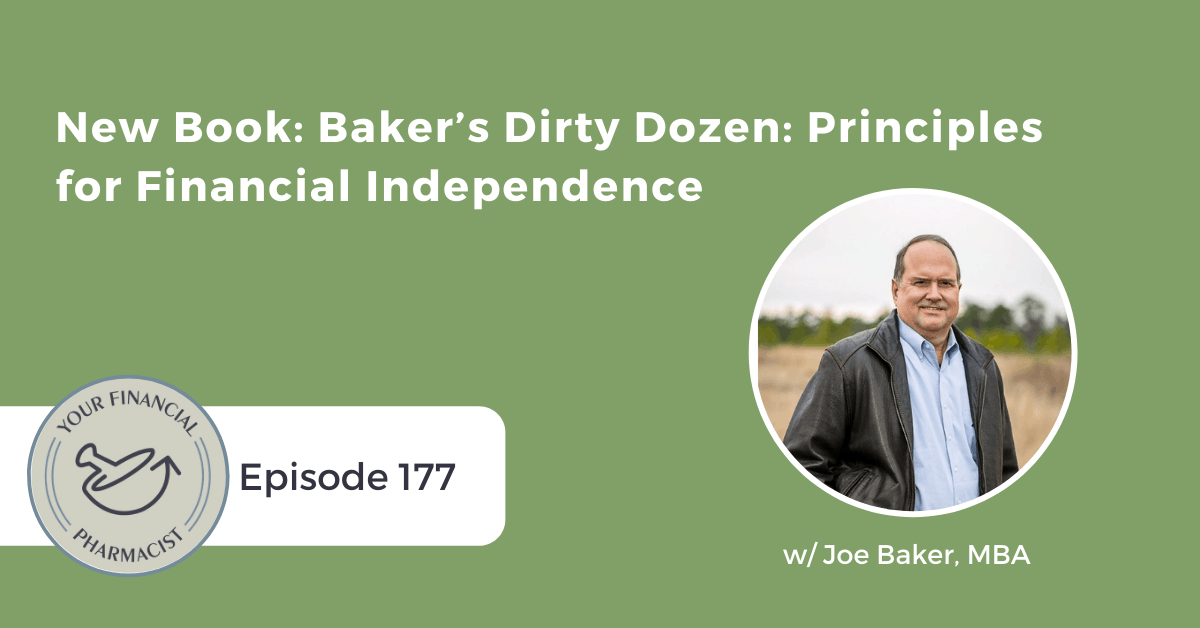
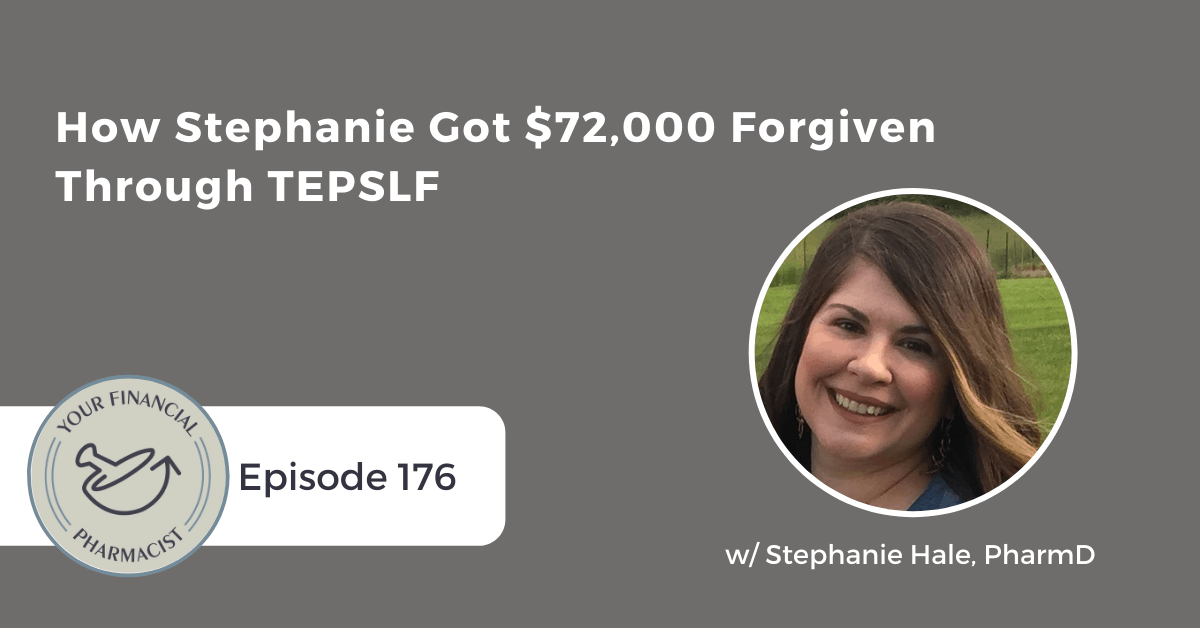
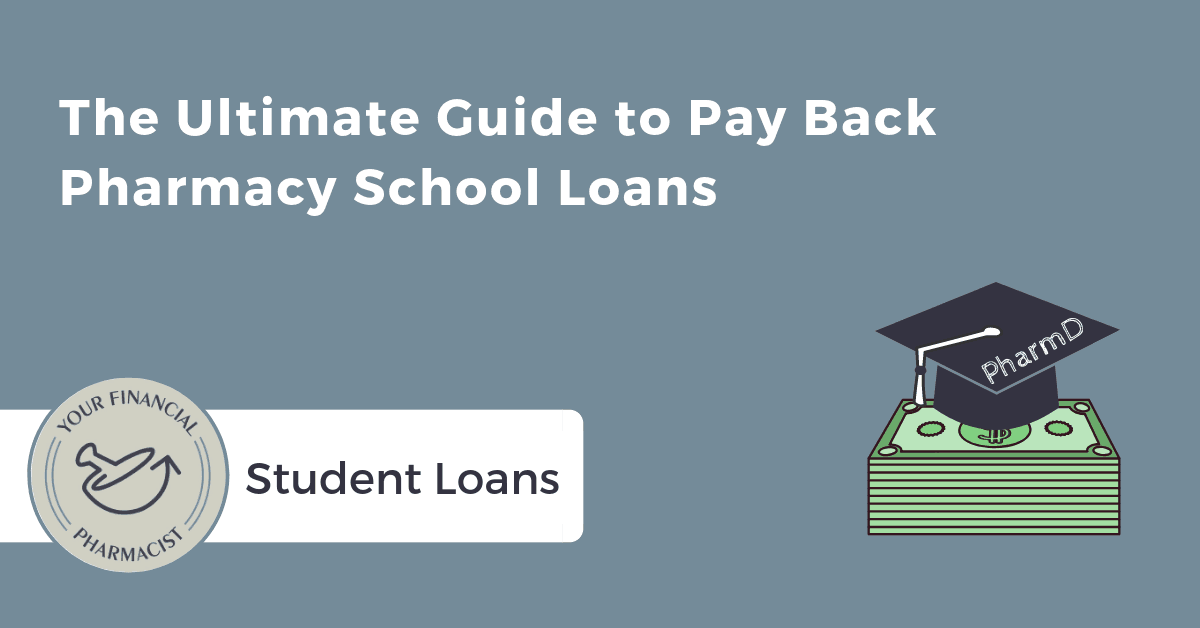
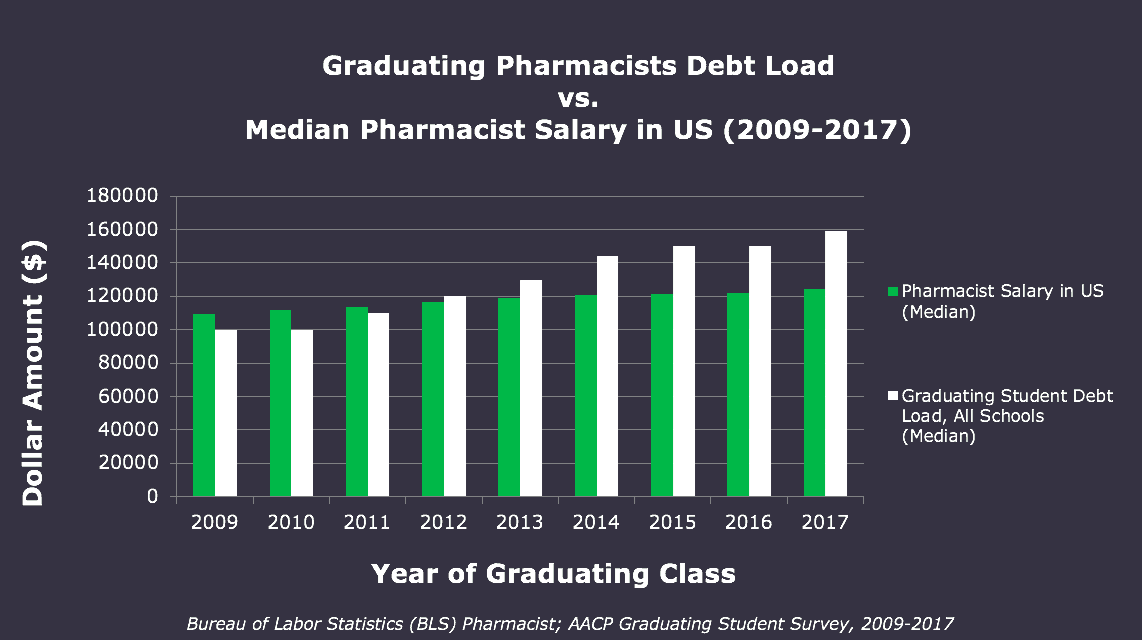 Therefore, now more than ever you as a pharmacist have to have a solid game plan to pay back pharmacy school loans. Pharmacy schools are not currently required to teach personal finance. Some offer electives and some provide education for their graduating class, but in general, the onus is on you to become informed. Sure, everyone is required to do the mandatory federal loan “exit” counseling but that’s really insufficient and doesn’t typically provide clarity in choosing the best payoff strategy.
With the multitude of student loan types, repayment plans, forgiveness programs, and
Therefore, now more than ever you as a pharmacist have to have a solid game plan to pay back pharmacy school loans. Pharmacy schools are not currently required to teach personal finance. Some offer electives and some provide education for their graduating class, but in general, the onus is on you to become informed. Sure, everyone is required to do the mandatory federal loan “exit” counseling but that’s really insufficient and doesn’t typically provide clarity in choosing the best payoff strategy.
With the multitude of student loan types, repayment plans, forgiveness programs, and 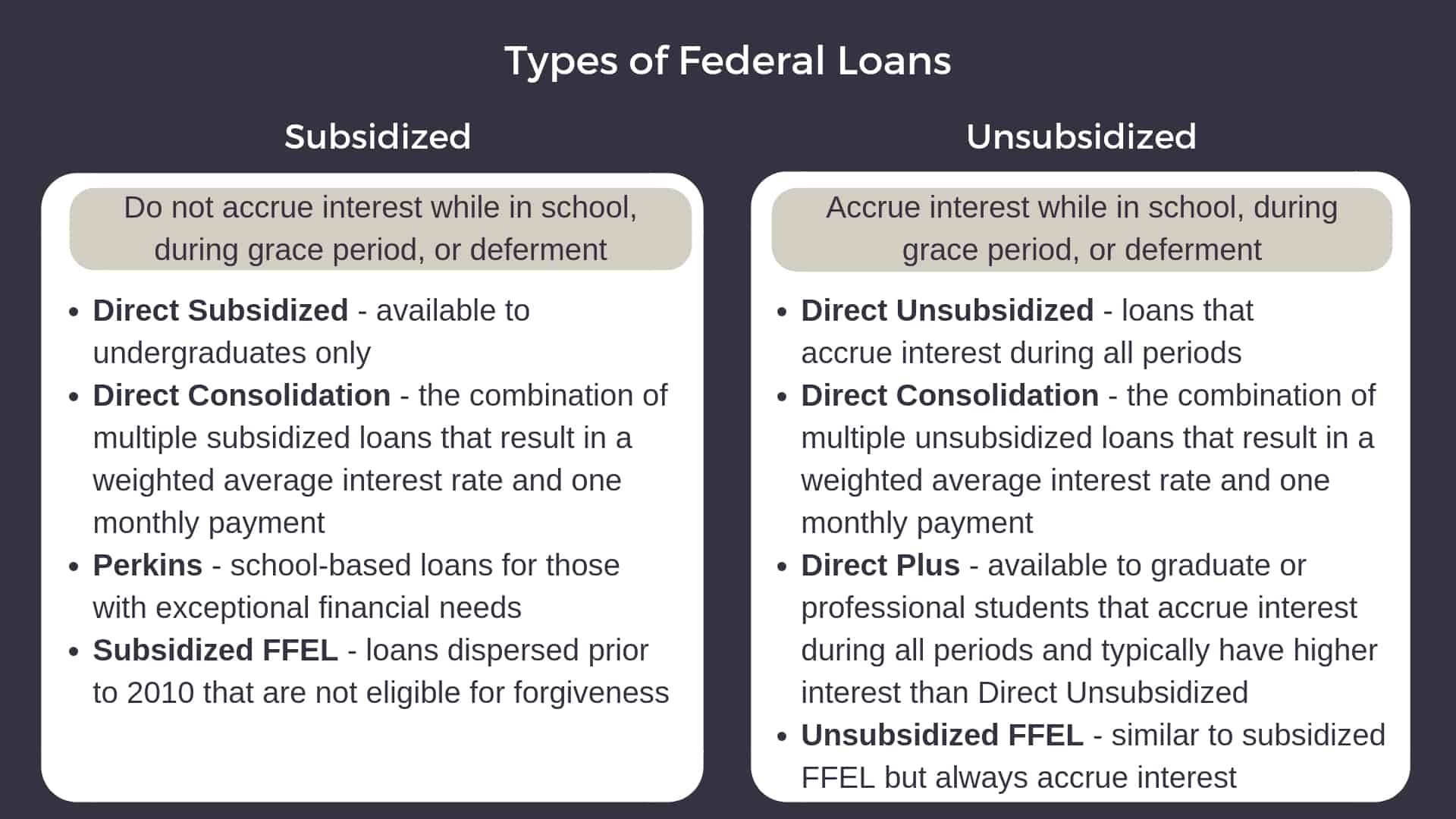
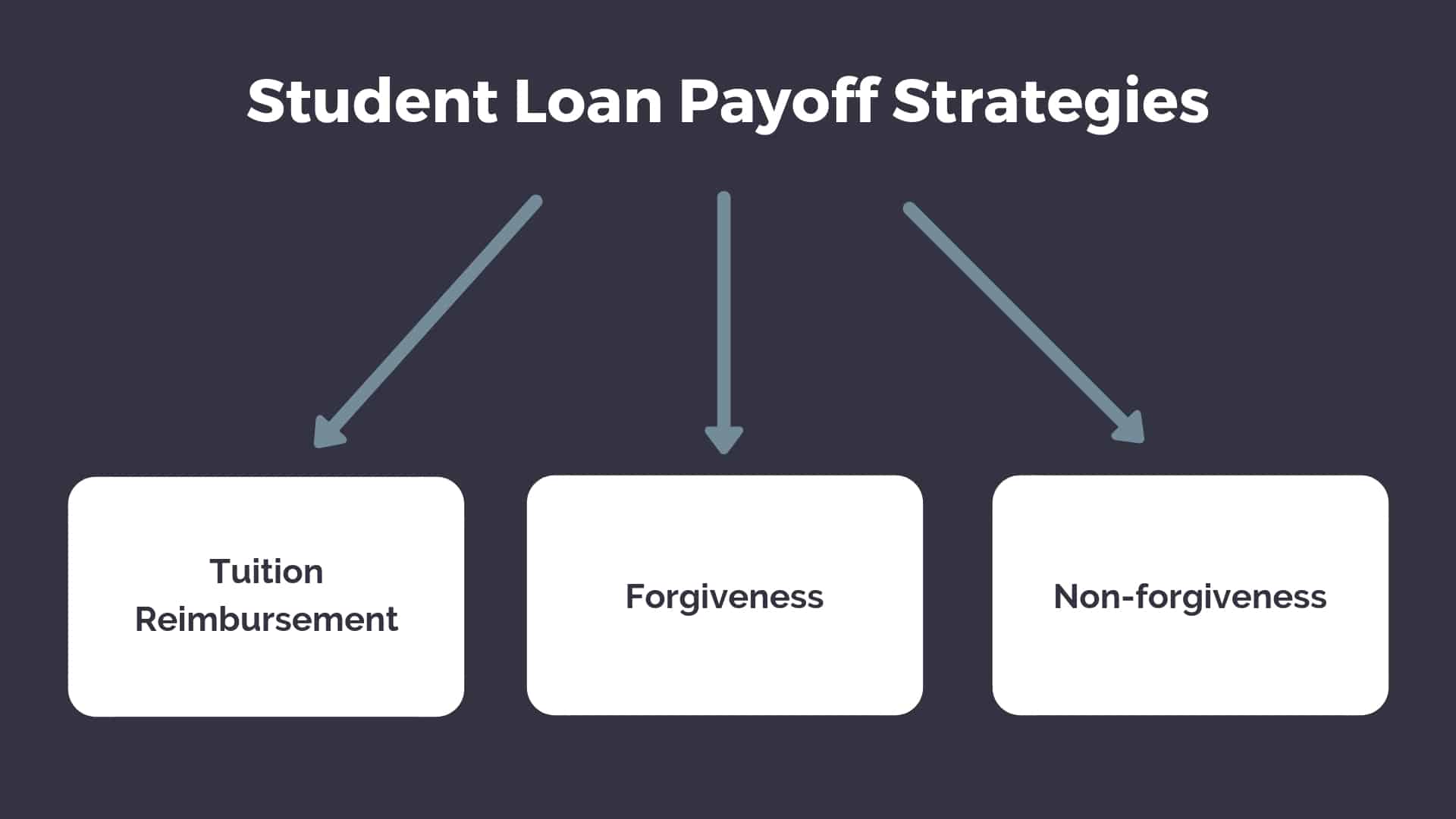
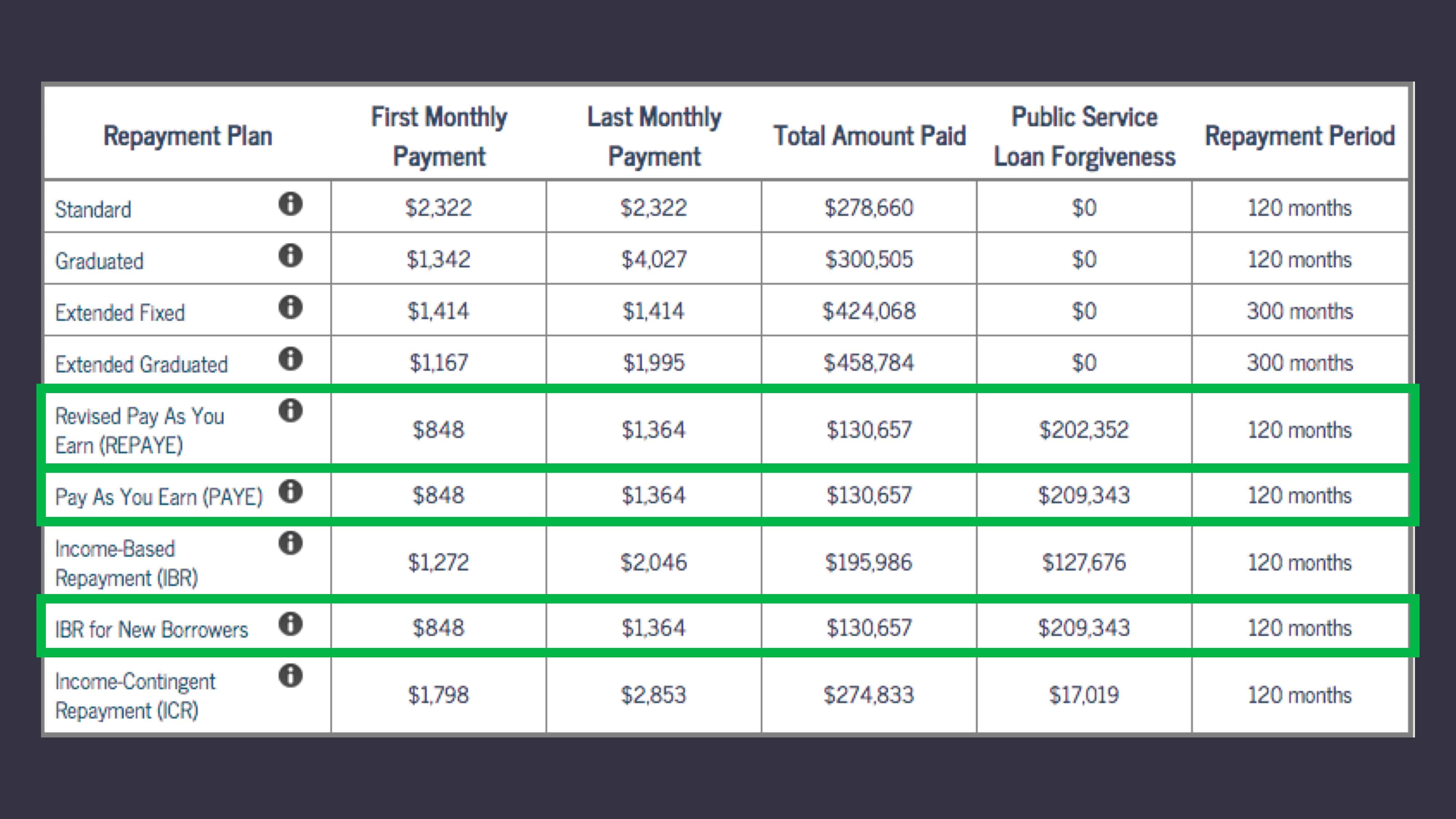 Compared to the 10-year Standard Repayment plan, pursuing forgiveness through REPAYE, PAYE, or IBR-New would result in only $130,657 paid, a difference of almost $150,000! Plus, the total amount paid could be even lower if the pharmacist were to maximize traditional 401(k) contributions and other options to lower adjusted gross income. Oh and that $209,343 loan balance remaining after 10 years? Forgedda bout it! It’s eliminated and no taxes to pay on that money.
Compared to the 10-year Standard Repayment plan, pursuing forgiveness through REPAYE, PAYE, or IBR-New would result in only $130,657 paid, a difference of almost $150,000! Plus, the total amount paid could be even lower if the pharmacist were to maximize traditional 401(k) contributions and other options to lower adjusted gross income. Oh and that $209,343 loan balance remaining after 10 years? Forgedda bout it! It’s eliminated and no taxes to pay on that money.
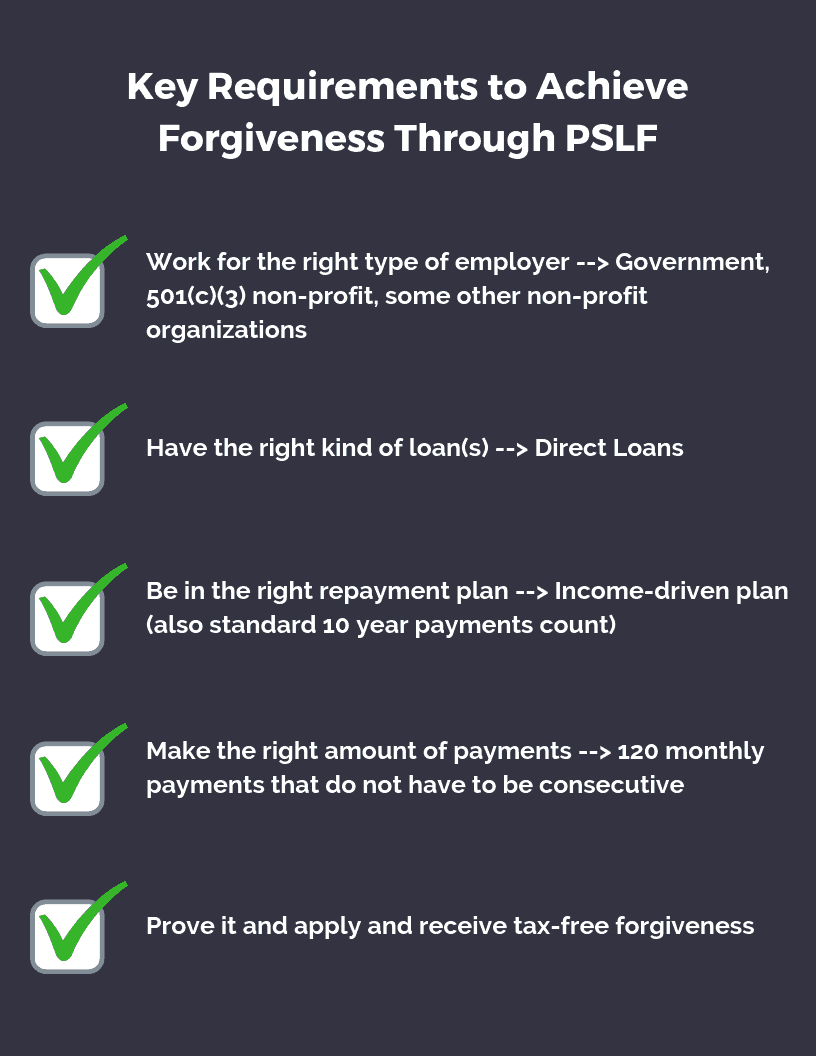 Qualified Employment
Qualified Employment
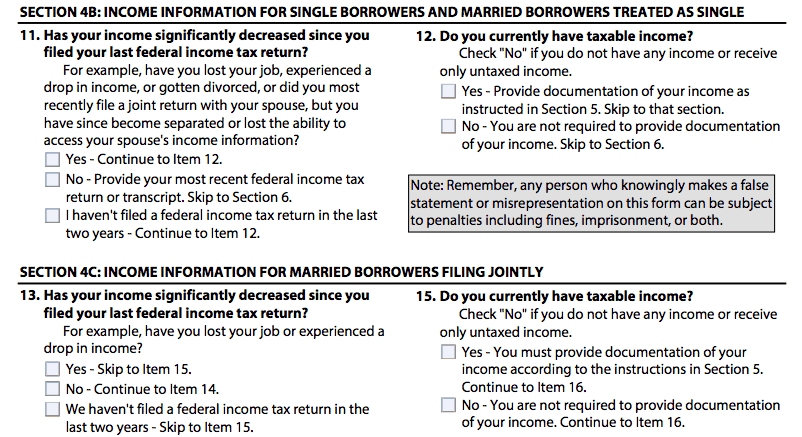 This is a big deal especially if you are a resident or fellow transitioning from student life or from resident to first-year practitioner. Previously, you would have had to disclose if your income increased which would be true going from having zero to minimal earnings as a student to 1/3 of a typical pharmacist salary or from resident to new practitioner.
However, with this change, you are going to pay substantially less during your transition years since your income is going to be based on the previous year’s earnings. Of course, you want to be truthful and accurate when filling out the form but if you are not required to disclose increases in your income then you shouldn’t. Why not take full advantage of the system in place?
Incorporating spousal income into this calculation will depend on the income-driven plan and how you file your taxes. For REPAYE, spousal income will count toward AGI regardless of how you file. If you file separate income tax returns, then only your income will be counted under PAYE (and IBR-New).
Initially, to qualify for PAYE you cannot have any outstanding loan balance on a Direct or FFEL Program loan when you received a Direct Loan or FFEL Program loan on or after October, 1, 2007, and you must have received a disbursement of Direct Loan on or after 10/1/11. Confusing right? If you can need more clarity on this check out
This is a big deal especially if you are a resident or fellow transitioning from student life or from resident to first-year practitioner. Previously, you would have had to disclose if your income increased which would be true going from having zero to minimal earnings as a student to 1/3 of a typical pharmacist salary or from resident to new practitioner.
However, with this change, you are going to pay substantially less during your transition years since your income is going to be based on the previous year’s earnings. Of course, you want to be truthful and accurate when filling out the form but if you are not required to disclose increases in your income then you shouldn’t. Why not take full advantage of the system in place?
Incorporating spousal income into this calculation will depend on the income-driven plan and how you file your taxes. For REPAYE, spousal income will count toward AGI regardless of how you file. If you file separate income tax returns, then only your income will be counted under PAYE (and IBR-New).
Initially, to qualify for PAYE you cannot have any outstanding loan balance on a Direct or FFEL Program loan when you received a Direct Loan or FFEL Program loan on or after October, 1, 2007, and you must have received a disbursement of Direct Loan on or after 10/1/11. Confusing right? If you can need more clarity on this check out 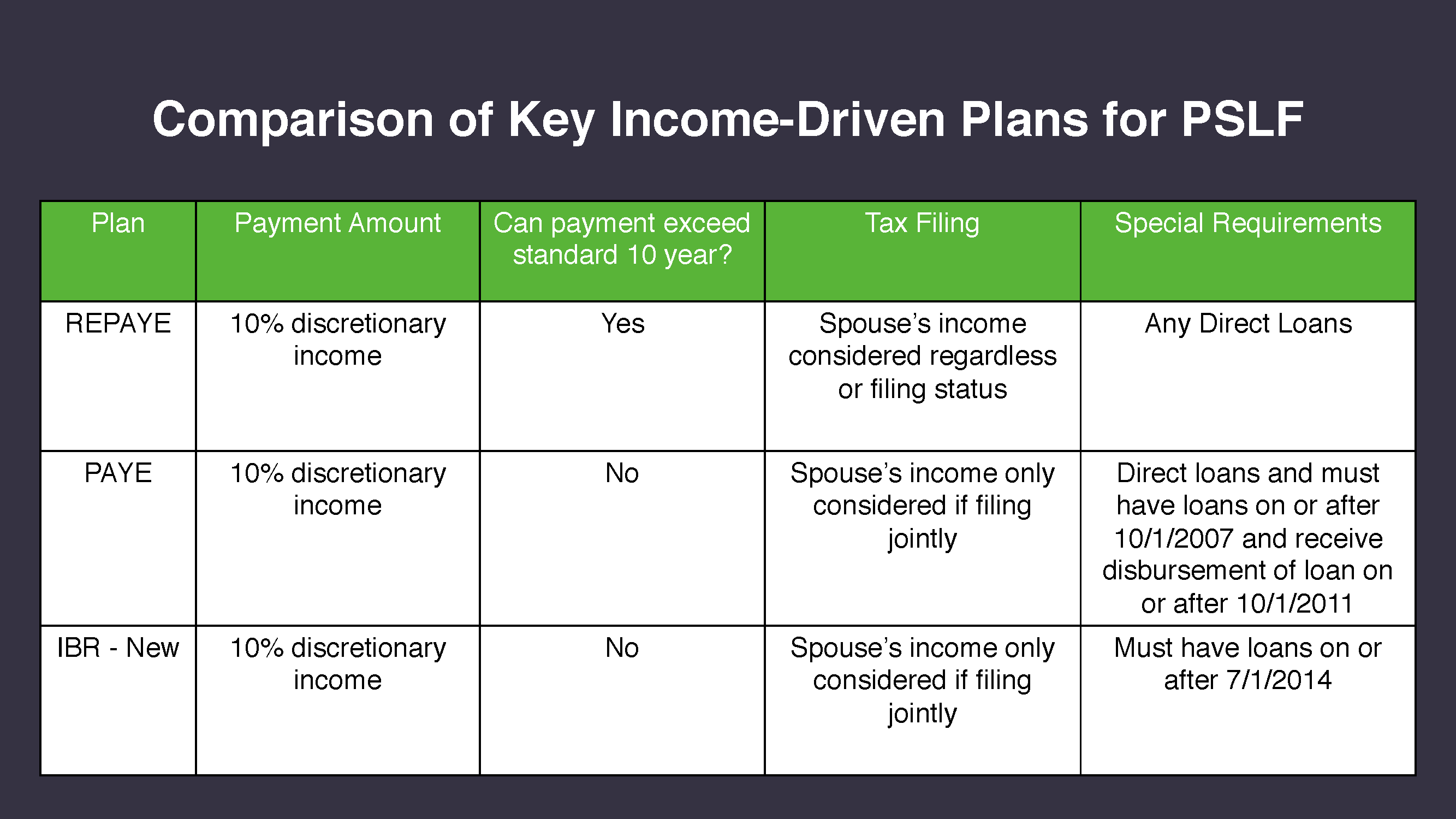
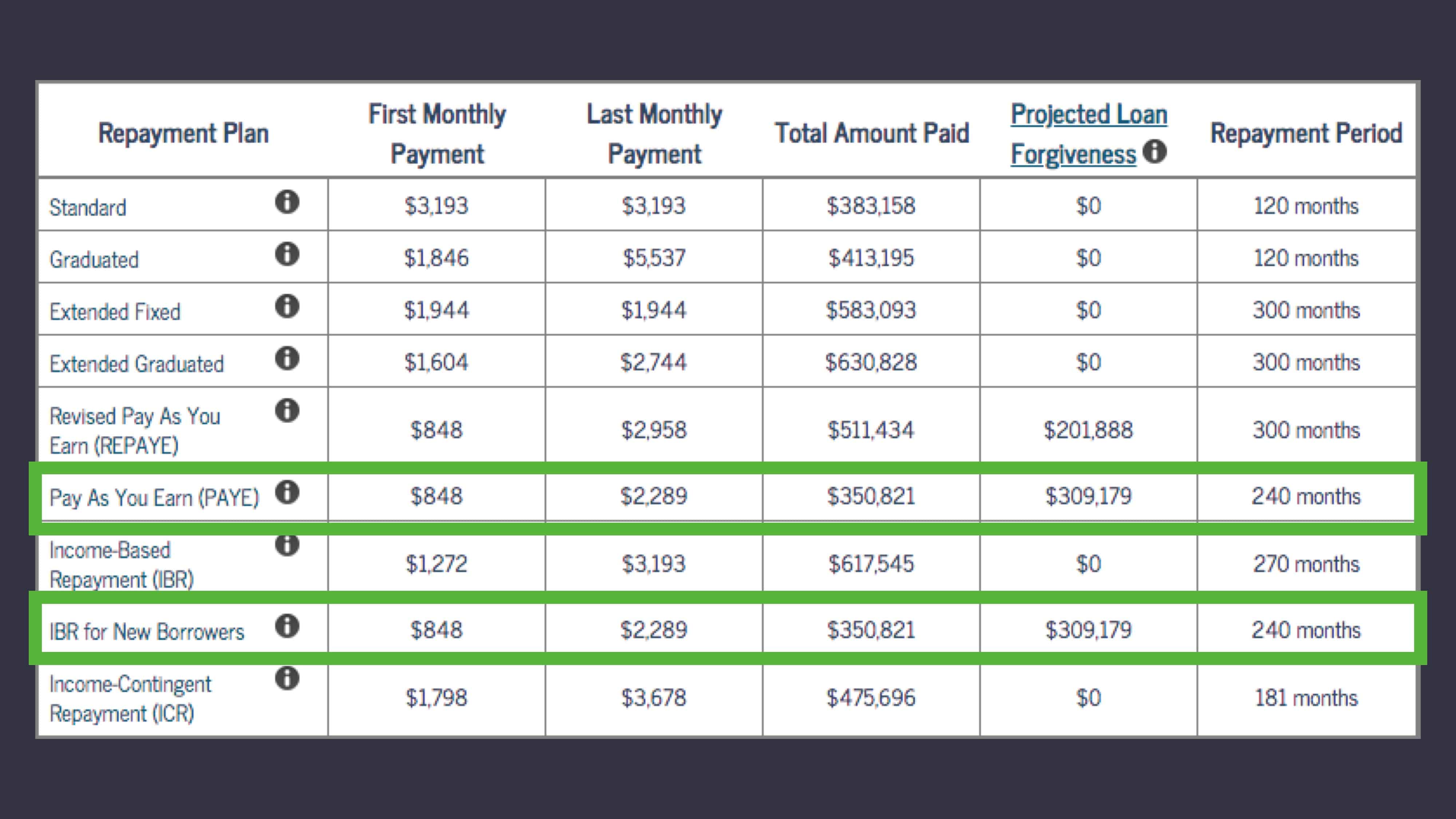 You can see that if this person were to extend payments out 25 years using the extended fixed plan, there would be a $1,944 payment and a total amount paid of $583,093. However, considering non-PSLF forgiveness using PAYE or IBR-New, payments would start $848 and increase to $2,289 (using a 5% increase in income/year per calculator assumption) and the total paid would only be $350,821. However, there would be $309,179 forgiven that is treated as taxable income. If we continue with the assumption of a 25% tax bracket, there would a tax bill of around $77,000. So even with the tax bomb, there are definitely some advantages here:
1. The total amount paid over 25 years will be much less even with considering the additional tax bill (by over $100,000).
2. For many of the years during repayment, the monthly payments will be significantly lower which allows more disposable income for retirement contributions and other financial goals.
3. The tax bill of $77,000 is in future value which is much less than it is today
You can see that if this person were to extend payments out 25 years using the extended fixed plan, there would be a $1,944 payment and a total amount paid of $583,093. However, considering non-PSLF forgiveness using PAYE or IBR-New, payments would start $848 and increase to $2,289 (using a 5% increase in income/year per calculator assumption) and the total paid would only be $350,821. However, there would be $309,179 forgiven that is treated as taxable income. If we continue with the assumption of a 25% tax bracket, there would a tax bill of around $77,000. So even with the tax bomb, there are definitely some advantages here:
1. The total amount paid over 25 years will be much less even with considering the additional tax bill (by over $100,000).
2. For many of the years during repayment, the monthly payments will be significantly lower which allows more disposable income for retirement contributions and other financial goals.
3. The tax bill of $77,000 is in future value which is much less than it is today
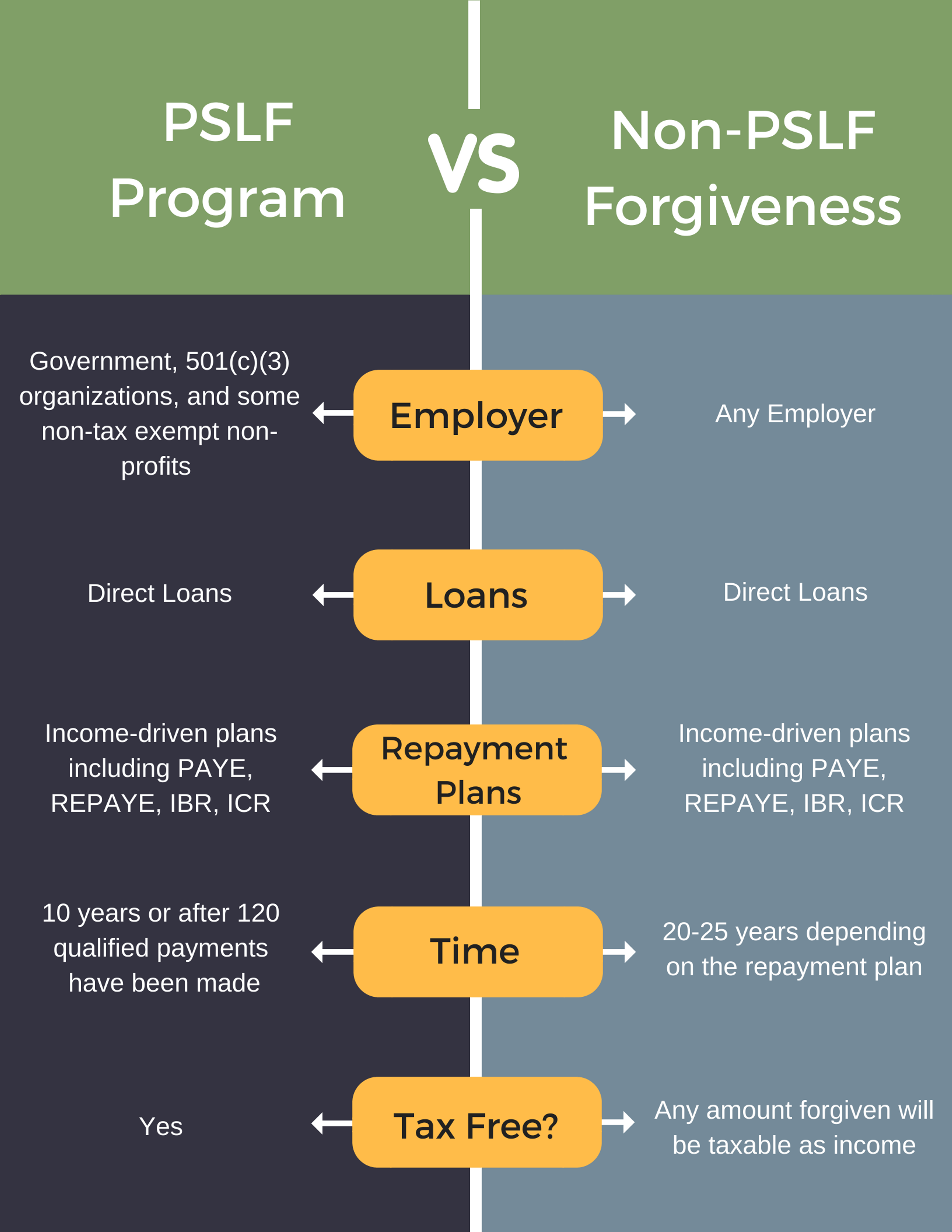
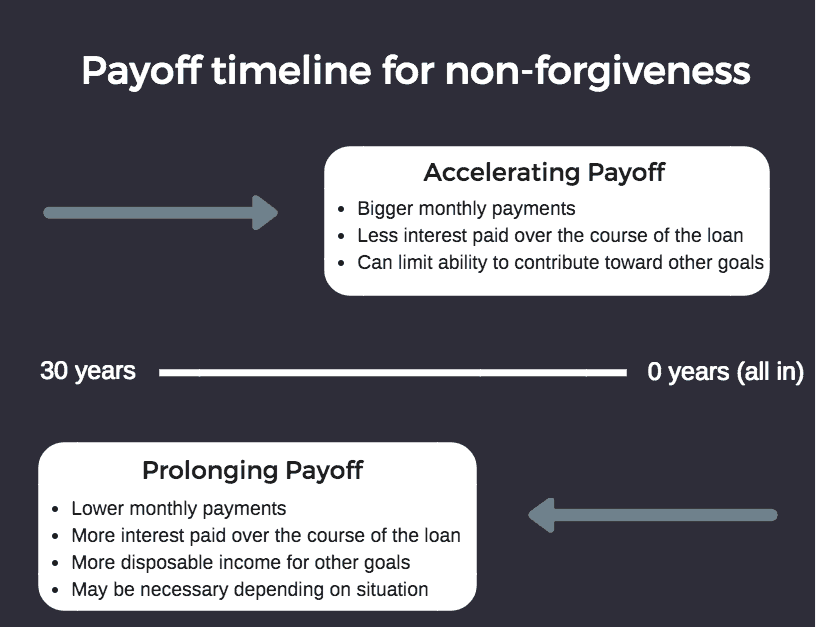
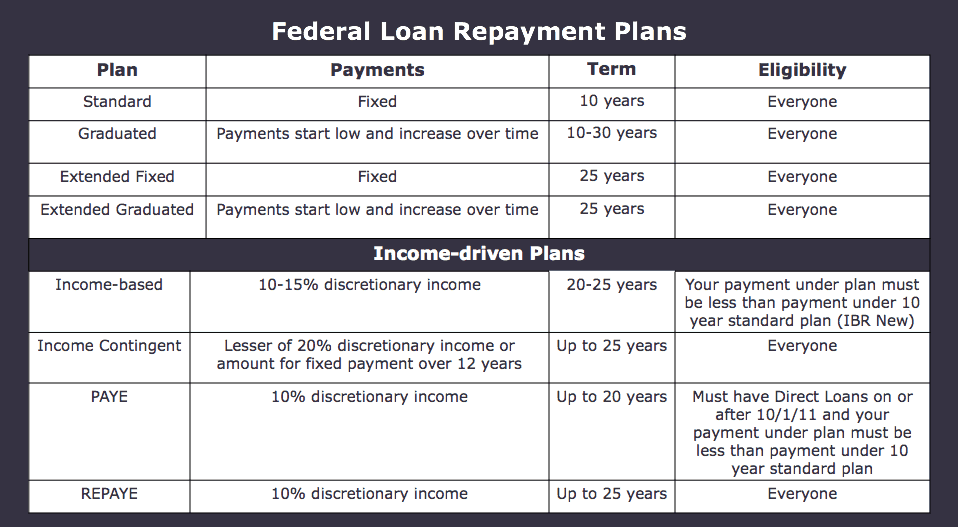 Advantages of the Federal Loan System
Keeping your loans in the federal system will give you some protection and safeguards that are not always available through private lenders. If you die or become permanently disabled, your loans will be discharged without any tax bill on that amount. In addition, if you’re facing a financial hardship, want to go back to school, or have circumstances where it could be tough to make payments, you can request deferment or forbearance which would result in a temporary stop in making payments. The other advantage is the ability to make income-driven payments if needed which generally is not available through private lenders. Lastly, all federal loans have fixed interest rates so your monthly payments will not change unless you are in an income-driven plan or one of the graduated plans.
Advantages of the Federal Loan System
Keeping your loans in the federal system will give you some protection and safeguards that are not always available through private lenders. If you die or become permanently disabled, your loans will be discharged without any tax bill on that amount. In addition, if you’re facing a financial hardship, want to go back to school, or have circumstances where it could be tough to make payments, you can request deferment or forbearance which would result in a temporary stop in making payments. The other advantage is the ability to make income-driven payments if needed which generally is not available through private lenders. Lastly, all federal loans have fixed interest rates so your monthly payments will not change unless you are in an income-driven plan or one of the graduated plans.

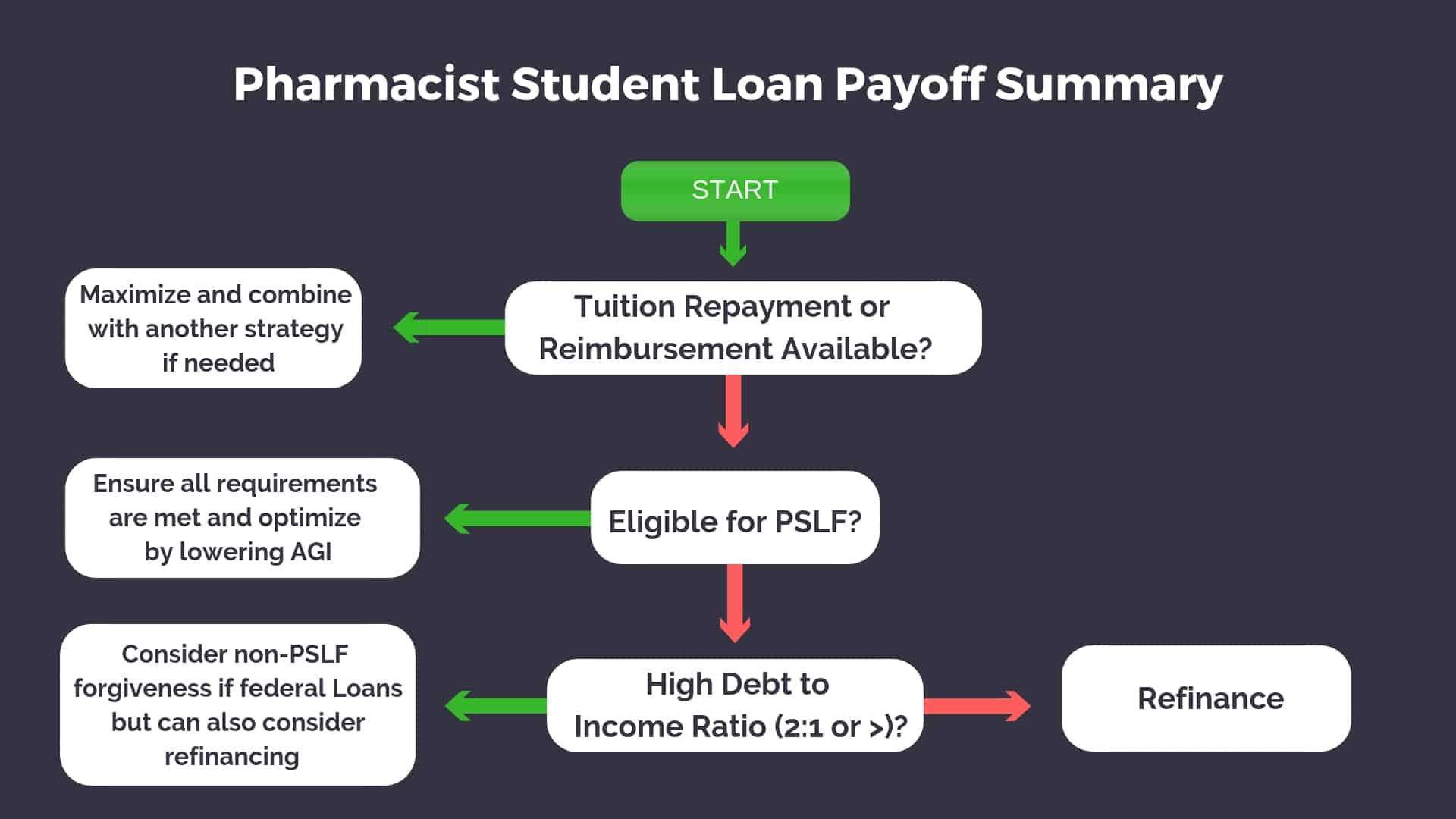 If you have the typical pharmacist student loan balance, it’s really hard to argue against PSLF. The math is not even close. You will pay thousands less than any other strategy. But not only that, you have the opportunity to optimize this strategy and be on the fast lane to building some serious wealth. Since your monthly payments through the program are dependent on your discretionary income and therefore adjusted gross income, there are ways you can lower payments while simultaneously investing aggressively. The key ways to do this will be maxing out traditional 401(k) contributions and HSA (if available to you). It’s possible to also count traditional IRA contributions. However, because the phase-out for this is a MAGI of $74,000 for single, and $123,000 for married filing jointly if you are covered by an employer-sponsored plan, most pharmacists will not be eligible to get the deduction. For more information on how to maximize forgiveness, check out this
If you have the typical pharmacist student loan balance, it’s really hard to argue against PSLF. The math is not even close. You will pay thousands less than any other strategy. But not only that, you have the opportunity to optimize this strategy and be on the fast lane to building some serious wealth. Since your monthly payments through the program are dependent on your discretionary income and therefore adjusted gross income, there are ways you can lower payments while simultaneously investing aggressively. The key ways to do this will be maxing out traditional 401(k) contributions and HSA (if available to you). It’s possible to also count traditional IRA contributions. However, because the phase-out for this is a MAGI of $74,000 for single, and $123,000 for married filing jointly if you are covered by an employer-sponsored plan, most pharmacists will not be eligible to get the deduction. For more information on how to maximize forgiveness, check out this 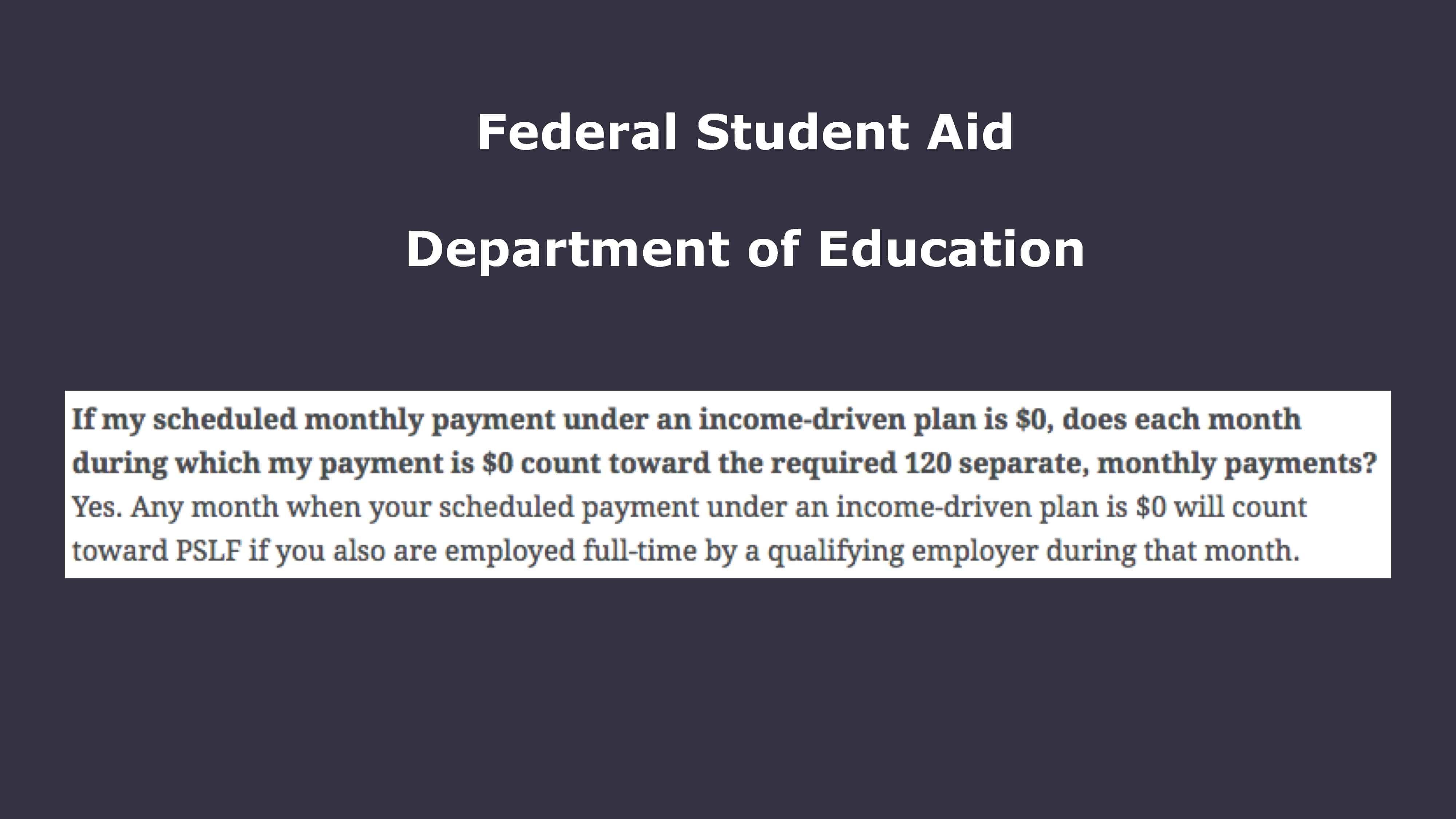 Even if you don’t continue working for a qualifying employer post-residency and won’t be pursuing PSLF, REPAYE would help reduce the accumulated interest during your years of training. Because the different repayment plans have different rules regarding how spousal income is incorporated you definitely want to also keep that in mind when choosing the best repayment plan during residency.
Even if you don’t continue working for a qualifying employer post-residency and won’t be pursuing PSLF, REPAYE would help reduce the accumulated interest during your years of training. Because the different repayment plans have different rules regarding how spousal income is incorporated you definitely want to also keep that in mind when choosing the best repayment plan during residency. 